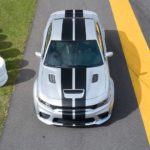The next-generation Dodge Charger has been officially revealed, and in a surprise announcement, it’s getting a gasoline engine option in addition to an all-electric powertrain. While only the electric Charger Daytona will be available for the 2024 model year, next year we will see the gasoline-powered Charger Sixpack, with the––you guessed it––six-cylinder Hurricane engine under the hood. There were plenty of rumors that Dodge wasn’t giving up entirely on gasoline muscle cars, but now that the official details have been released, it’s time to dig in and see if the new Hurricane is the real deal or just a bandaid to cover up the demise of the HEMI V8.
Eight Cylinders vs Six Cylinders and Two Turbos
The HEMI V8 has been a part of the Dodge mythos since the 1950s, although it took a long vacation from the lineup between the end of Dodge muscle car production in 1971 and the reintroduction of the Dodge Charger in 2006. The modern HEMI V8 in the 2023 Charger and Challenger comes in a variety of flavors, including the reliable 5.7L, the potent 6.4L, and the mind-bending 6.2L Hellcat. Those three engines range from a mere 370 hp all the way up to a demonic 1,025 hp, depending on the exact model in question. Needless to say, that’s a tall order for the new Hurricane engine to live up to.
We first got a taste of the Hurricane in the 2022 Grand Wagoneer, and it has since spread across the Stellantis lineup before finding its way to Dodge for the 2025 Charger Sixpack. This engine is a twin-turbocharged 3.0L inline-six, very similar to the S58 engine that powers the BMW M2, M3, and M4 sports sedans. The six cylinders are divided into two groups of three, each fed by its own turbocharger. Two versions of the Hurricane are available, offering slightly different outputs depending on the model in question. In the 2025 Charger, the standard output variant will offer 420 hp, while the high output option will provide 550 hp.
Those two outputs neatly one-up the naturally-aspirated HEMI options, with the standard output Hurricane providing 13.5% more power than the 5.7L V8 and the high output Hurricane offering 13.4% more than the 6.4L V8. The addition of all-wheel drive (which was only an option for the V6 engines in the 2023 cars) will also help put that power to the ground, although the extra performance will likely be offset by the larger dimensions of the 2025 Charger. In short, we can expect the new Charger to be a bit faster than the old Charger, though likely not by a large amount (although the turbocharged nature of the new engine means adding power is a lot easier than with a naturally-aspirated V8).
But What About the Hellcat?
Overall, the new Hurricane engine is shaping up to be a solid replacement for the 5.7L and 6.4L HEMI V8 options, trading a bit of noise and heritage for added torque and tunability. But what about the Hellcat? After all, it’s the engine that made the Charger and Challenger the icons that they are. Unfortunately, while forced induction is a replacement for displacement, a smaller turbocharged engine still can’t compete with a larger supercharged engine. With no less than 183 hp per liter, the high-output Hurricane is already a phenomenal engine that is more power-dense than even the 6.2L Hellcat Demon 170 running on E85. But a 3.0L displacement means it can only do so much.
Dodge has made it crystal clear that the HEMI is dead after the 2023 model year, and that includes the Hellcat. As much as we might want to dream about a larger engine based on the Hurricane (perhaps a 6.0L V12 to rival Lamborghini?), that probably isn’t in the cards. Instead, the replacement for the Hellcat is the all-electric Charger Daytona. The 2024 Daytona Scat Pack promises a 3.3 second zero to 60 mph time and 11.5 second quarter mile time, putting it ahead of the Challenger Jailbreak with its 807 hp Hellcat engine. That’s still not quite up to Challenger Demon 170 numbers, but Dodge has already told us that an even more powerful Daytona SRT Banshee variant is in the works, and electric cars have already proven capable of dethroning even the most powerful gasoline cars on the drag strip.
Can Dodge Exorcize the HEMI?
Objectively, the new Charger is an excellent replacement for the older Charger and Challenger. It is more comfortable, more technologically advanced, and designed for sportier driving dynamics. Plus, the new Hurricane engine is more powerful than the naturally-aspirated 5.7L and 6.4L HEMI V8 options. Even though there isn’t a gasoline-powered replacement for the mighty Hellcat engines, the electric Charger Daytona will likely leave even the Demon 170 in its dust once the SRT Banshee is revealed. However, it remains to be seen whether Dodge can ever exorcize the HEMI or if its discontinued V8 engines will continue to haunt it. There is a lot of attachment to the eight-cylinder layout, and it isn’t clear that the Hurricane or the Daytona is superior enough for Dodge fans to leave the HEMI in the past.





